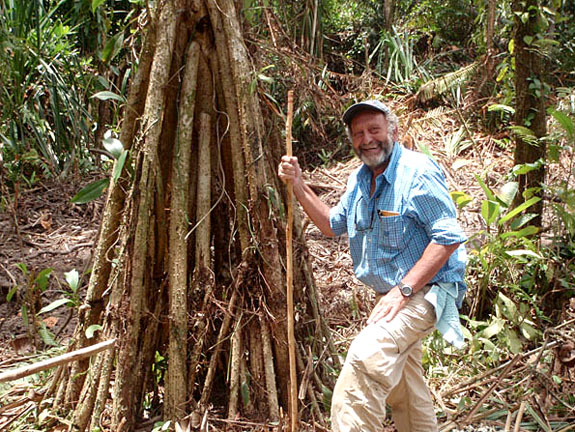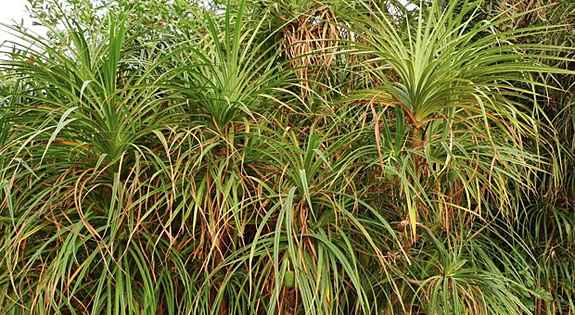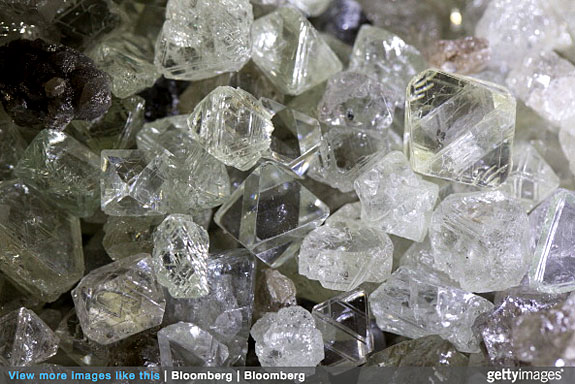May 21st, 2015
A Florida geologist has discovered an unusual palm-like plant that only grows in diamond-rich soil.
More specifically, the stilted, thorny Pandanus candelabrum thrives in the potassium, phosphorous and magnesium-rich soil that sits above kimberlite pipes — the volcanic superhighways that deliver precious diamonds from deep within the earth to the surface.

Most of the world’s commercial diamond production is derived from kimberlite pipes and the Pandanus candelabrum plant is the world's only botanical indicator for kimberlite. Where you find this rare plant, you're likely to find diamonds.
Stephen Haggerty, a professor of geophysics at Florida International University in Miami, is credited with making the connection between the palm plant and diamond prospecting. He published his findings in the June-July edition of Economic Geology.

The special connection between kimberlite and the strange plant with stilt-like roots could change the way prospectors in West Africa search for diamonds. Instead of utilizing heavy gear for strip mining, they can simply pinpoint their excavation efforts to where the prickly palm is flourishing — thereby preserving the environment.
Hagerty claims that, until recently, there was no reliable way to locate these small, but concentrated, deposits of diamonds hidden in the remote and dense jungle. Some diamond-rich areas are only a few acres in size.

According to Science magazine, Hagerty’s clever hypothesis is already yielding real results. In a test site inhabited by the Pandanus candelabrum, Hagerty secured four diamonds, two of them around 20 carats apiece.
Interestingly, the palm/diamond association has been played out with other flora and precious materials across the globe.
In 2013, we wrote about Australian researchers who discovered that the roots of eucalyptus trees have the ability to draw up tiny gold particles from deep within the soil, with the gold eventually collecting in the leaves and branches. Finding precious metal in the leaves is a certain indicator of the presence of valuable gold deposits 100 feet or more below the surface.
Science magazine reported that Lychnis alpina, a small pink-flowering plant in Scandinavia, and Haumaniastrum katangense, a white-flowered shrub in central Africa, are both associated with copper. And PBS.com noted that a the presence of a certain type of grass native to California is a dependable sign of nickel and chromium in the soil.
Credits: Photo of Stephen Haggerty and the Pandanus candelabrum: Uncredited via fiu.edu.; Tree by Jakob Fahr/iNaturalist (CC BY-NC) via Wikimedia Commons; Rough diamonds via Getty Images.
More specifically, the stilted, thorny Pandanus candelabrum thrives in the potassium, phosphorous and magnesium-rich soil that sits above kimberlite pipes — the volcanic superhighways that deliver precious diamonds from deep within the earth to the surface.

Most of the world’s commercial diamond production is derived from kimberlite pipes and the Pandanus candelabrum plant is the world's only botanical indicator for kimberlite. Where you find this rare plant, you're likely to find diamonds.
Stephen Haggerty, a professor of geophysics at Florida International University in Miami, is credited with making the connection between the palm plant and diamond prospecting. He published his findings in the June-July edition of Economic Geology.

The special connection between kimberlite and the strange plant with stilt-like roots could change the way prospectors in West Africa search for diamonds. Instead of utilizing heavy gear for strip mining, they can simply pinpoint their excavation efforts to where the prickly palm is flourishing — thereby preserving the environment.
Hagerty claims that, until recently, there was no reliable way to locate these small, but concentrated, deposits of diamonds hidden in the remote and dense jungle. Some diamond-rich areas are only a few acres in size.

According to Science magazine, Hagerty’s clever hypothesis is already yielding real results. In a test site inhabited by the Pandanus candelabrum, Hagerty secured four diamonds, two of them around 20 carats apiece.
Interestingly, the palm/diamond association has been played out with other flora and precious materials across the globe.
In 2013, we wrote about Australian researchers who discovered that the roots of eucalyptus trees have the ability to draw up tiny gold particles from deep within the soil, with the gold eventually collecting in the leaves and branches. Finding precious metal in the leaves is a certain indicator of the presence of valuable gold deposits 100 feet or more below the surface.
Science magazine reported that Lychnis alpina, a small pink-flowering plant in Scandinavia, and Haumaniastrum katangense, a white-flowered shrub in central Africa, are both associated with copper. And PBS.com noted that a the presence of a certain type of grass native to California is a dependable sign of nickel and chromium in the soil.
Credits: Photo of Stephen Haggerty and the Pandanus candelabrum: Uncredited via fiu.edu.; Tree by Jakob Fahr/iNaturalist (CC BY-NC) via Wikimedia Commons; Rough diamonds via Getty Images.



